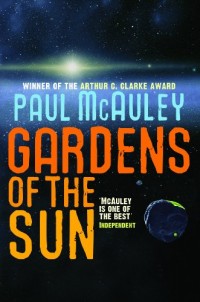Monsters are always lonely
 Gardens of the Sun
Gardens of the Sun
by Paul McAuley
This is a sequel to The Quiet War, a space opera that Tim encouraged me to read last summer. Then a few months later he started bugging me to read the sequel, so he could discuss the pair without accidentally spoiling the plot for me, because he couldn’t entirely remember which events happened in which book! It’s actually a trilogy, but neither of us has read part three yet. My review does contain spoilers for The Quiet War, because this book is very much an immediate continuation of events in that book.
I actually preferred this to the first book, as I felt the politics and philosophical debates were more varied, with more views and nuances depicted. Naturally the themes are largely the same: genetic modification; human responsibility for our planet and our fellow man; the endless possibilities of science and whether we should always pursue every avenue; diplomacy; whether good and evil are inherent or a product of circumstances and therefore variable; freedom; love, family and parenting. Just a few small things then!
The story begins soon after the end of the Quiet War (which, as a reminder, was between the Earth’s three major governing powers and the Outers who inhabit the Saturn and Jupiter systems). Earth’s TPA has taken control of the Saturn and Jupiter systems, imprisoning all Outers who stayed behind. A small number of Outers fled further out from the Sun. Calling themselves the Free Outers, they are hunted by the TPA and must keep on moving from one moon or asteroid to the next, rebuilding their lives again and again. Fissures soon appear in the TPA itself, with the Pacific Community preferring a much softer approach to occupation than the military overbearance of Greater Brazil, and the Europeans caught in-between.
“A fundamental truth: monsters are always lonely, because they can’t connect with ordinary people in any ordinary way. People fear and persecute monsters because they are different, and monsters despise and torment people because, despite their weakness and inferiority, they possess the one thing that monsters can never possess: the fellowship of the herd.”
The major characters here are the same ones we first encountered in The Quiet War. Once again, chapters alternate between them and for most of the book their stories don’t really intersect, though they are affected by the same major events. This keeps the story moving along, as there is a massive timeframe being covered. Unlike The Quiet War, which covered maybe a few months in time, of which only days were the war itself, Gardens of the Sun covers many years. This feels like a realistic timeframe to fully explore the aftermath of a major conflict, the reverberations and changes that happen, both expected and unexpected.
There were three characters in The Quiet War who seemed pretty much awful people: geneticist Sri Hong-Owen, political adviser Loc Ifrahim and the Spy (who has multiple names). Here they all become much more difficult to pin down on the good-bad spectrum, and therefore, to me, more interesting. However, I was less interested this time round in Macy Minnot, an Earth-born biologist who has joined the Free Outers and is arguably the heroine of both books. She’s unambiguously good and her decisions always clearly right, so while I cared about her, I was more excited by the other storylines. My favourite storyline, oddly enough, was the one I was least interested by in The Quiet War. I can’t say much without spoiling the early chapters, but I thought it was an excellent look at PTSD, military vs civilian life, alcoholism and anger.
“He felt as if he’d been beaten by experts and afterwards staked out in the scorching heat of some desert on Earth. Bruised to the bone, joints stiff and swollen. A black headache pulsing like a poisonous spider inside the tender jelly of his brain. His tongue a shrivelled corpse glued to the floor of its foul tomb.”
There’s a fair bit of science and McAuley’s background in biology and botany definitely shows its hand. This was slightly less true of the first book, and arguably gardening/botany is central to this volume, but it did feel a little as though all other scientific fields had been abandoned or forgotten by the people in this universe. However, McAuley’s writing also clearly references an awful lot of astrophysics in his detailed and beautiful descriptions of planets, asteroids and space travel. He makes some very complex science about different planetoid compositions, atmospheres and gravities comprehensible and enjoyable to read, which is no mean feat.
Tim and I had some long, in-depth discussions that are definitely too spoilerific to repeat here, but that certainly show how we were both thoroughly engaged in the world McAuley created and respond to it on personal, political and philosophical levels. I am curious about the third volume, In the Mouth of the Whale, partly because it has a great title and I like McAuley’s writing, but also because I’m not sure where this story can go next. Unlike the middle volume in many trilogies, this book clearly wraps up events and doesn’t leave a cliffhanger for the next book to resolve.
Published 2009 by Gollancz.
Source: Borrowed from Tim.
This series sounds interesting, I might have to try reading part 1. Space opera isn’t something I’d read much of until quite recently, when I got quite hooked on Iain Banks’ Culture Series. They have some interesting concepts in and are really a lot of fun to read.
Yes, the description “space opera” wouldn’t be an attractor for me either but this series definitely works for me. I’ve been meaning to check out the Iain Banks Culture series too.